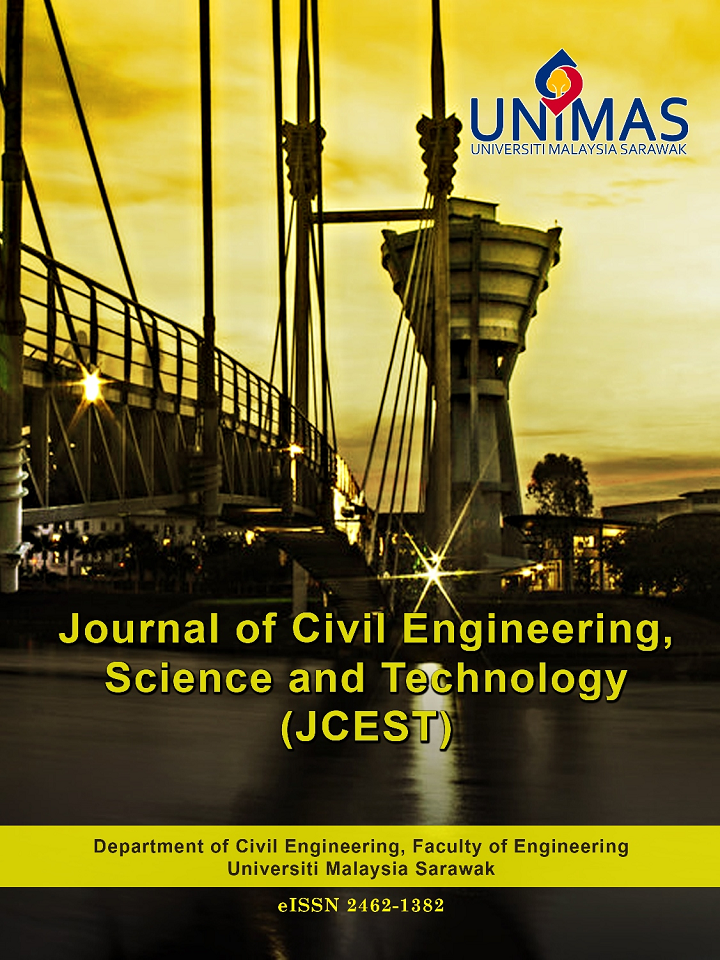COMPARISON OF THE BEHAVIOR OF FIBER AND MESH REINFORCED SOILS
DOI:
https://doi.org/10.33736/jcest.441.2017Abstract
Soft soil does not have good soil properties and is not suitable for constructing pavement structures as shear strength is required to resist the shear stress developed by traffic loading. To increase shear strength in this study, lime is used as the soil stabilizing agent and fiber and mesh are used as the soil reinforcement materials. The proper amount of lime added to soil will increase the shear strength as the lime-treated soil will decrease moisture susceptibility and migration. Shear strength of the lime-treated soil can be further improved by adding reinforcement materials such as fiber and mesh. The reinforcement materials will interlock with groups of particles and provide tensile strength to the soil matrix. The type of soil used in this study is high plasticity elastic silt with sand which is classified using the Unified Soil Classification System (USCS). Quicklime (calcium oxide) is used in this study at the minimum amount required for stabilizing the soil, which is 9%. The amount of fiber and mesh added to the soil sample is 0.5% of the dry weight of the soil used. Cylindrical samples were prepared with a moisture content of 22% (OMC) for untreated soil and 21% (OMC) for lime-treated soil samples. The lime-treated soil samples were cured for 7, 14, 28, 56, 90 and 120 days. Unconfined compression tests were conducted to determine unconfined compressive strength (UCS) and stress-strain characteristics. The unconfined compressive strength of the lime-treated samples increased as curing period increased but the failure strain decreased. The UCS and failure strain for reinforced lime-treated soil samples are higher than the unreinforced lime-treated soil samples.
References
Kolias, S., Kasselouri-Rigopoulou, V., & Karahalios, A. (2005). Stabilization of clayey soils with high calcium fly ash and cement. Cement Concrete Composite, 27, 301-313.
https://doi.org/10.1016/j.cemconcomp.2004.02.019
Sharma, N.K., Swain, S. K., Sahoo, & U.C. (2012). Stabilization of a clayey soil with fly ash and lime: a micro level investigation. GeotechGeolEng, 30, 1197-1205.
https://doi.org/10.1007/s10706-012-9532-3
Ahmad, F., Bateni, F., & Azmi, M. (2009). Performance evaluation of silty sand reinforced with fibres. Geotextiles and Geomembranes, 28, 93-99.
https://doi.org/10.1016/j.geotexmem.2009.09.017
British Standard Institution. (1990). BS 1924, Stabilised Materials for Civil Engineering Purposes. London, UK: British Standard Institution.
British Standard Institution. (1990). BS 1377, Methods of Test for Soils. London, UK: British Standard Institution.
Downloads
Published
How to Cite
Issue
Section
License
Upon acceptance of an article, the corresponding author on behalf of all authors will be asked to complete and upload the Copyright Transfer Form (refer to Copyright Issues for more information on this) alongside the electronic proof file.
Copyright Transfer Statement for Journal
1) In signing this statement, the author(s) grant UNIMAS Publisher an exclusive license to publish their original research papers. The author(s) also grant UNIMAS Publisher permission to reproduce, recreate, translate, extract or summarize, and to distribute and display in any forms, formats, and media. The author(s) can reuse their papers in their future printed work without first requiring permission from UNIMAS Publisher, provided that the author(s) acknowledge and refer the publication in the Journal.
2) For open-access articles, the author(s) agree that their articles published under UNIMAS Publisher are distributed under the terms of the Creative Commons Attribution-NonCommercial-ShareAlike 4.0 International License (CC BY-NC-SA 4.0) which permits unrestricted use, distribution, and reproduction in any medium, for non-commercial purposes, provided the original work of the author(s) is properly cited.
3) For subscription articles, the author(s) agree that UNIMAS Publisher holds the copyright or an exclusive license to publish. Readers or users may view, download, print, and copy the content, for academic purposes, subject to the following conditions of use: (a) any reuse of materials is subjected to permission from UNIMAS Publisher; (b) archived materials may only be used for academic research; (c) archived materials may not be used for commercial purposes, which include but not limited to monetary compensation by means of sale, resale, license, transfer of copyright, loan, etc.; and (d) archived materials may not be re-published in any part, either in print or online.
4) The author(s) are responsible to ensure their submitted work is original and does not infringe any existing copyright, trademark, patent, statutory right, or propriety right of others. The corresponding author has obtained permission from all co-authors prior to submission to the journal. Upon submission of the manuscript, the author(s) agree that no similar work has been or will be submitted or published elsewhere in any language. If the submitted manuscript includes materials from others, the authors have obtained permission from the copyright owners.
5) In signing this statement, the author(s) declare that the researches which they have conducted comply with the current laws of the respective country and UNIMAS Journal Publication Ethics Policy. Any experimentation or research involving humans or the use of animal samples must obtain approval from the Human or Animal Ethics Committee in their respective institutions. The author(s) agree and understand that UNIMAS Publisher is not responsible for any compensational claims or failure caused by the author(s) in fulfilling the above-mentioned requirements. The author(s) must accept the responsibility for releasing their materials upon request by Chief Editor or UNIMAS Publisher.
6) The author(s) should have participated sufficiently in the work and ensured the appropriateness of the content of the article. The author(s) should also agree that they have no commercial attachments (e.g. patent or license arrangement, equity interest, consultancies, etc.) that might pose any conflict of interest with the submitted manuscript. The author(s) also agree to make any relevant materials and data available upon request by the editor(s) or UNIMAS Publisher.

